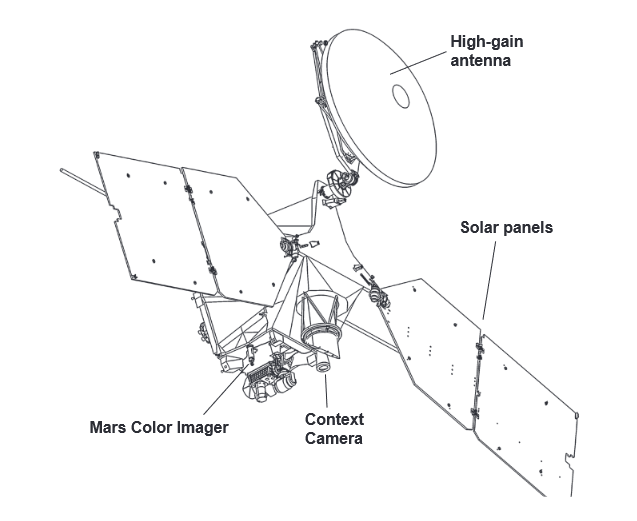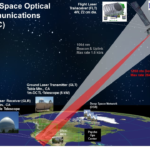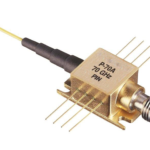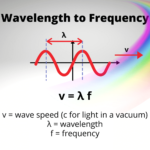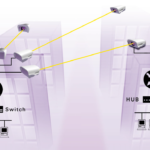Using laser-sourced light beams rather than wireless RF to link spacecraft with Earth offers the possibility of a significant increase in data rates. Still, there are significant technical challenges to the concept.
Scientists, engineers, and researchers communicating with spacecraft have a problem: there’s so much data coming from these spacecraft – and to send to some of them – that data rate ceilings are a serious problem. Depending on distance, spacecraft type, available power, and other factors, these links are running at rates as low as a few kbits/sec to several hundred kilobits/sec, with a few at higher rates and some even higher power. As an extreme case, the Voyager 1 and Voyager 2 spacecraft, both launched in 1997, are over 10 billion miles from Earth and have left our solar system and entered the heliosphere; they are still sending data in the one bit/sec range.
Achieving higher data rates is a classic tradeoff problem in the face of severe limitations and constraints. The problem of the need for ever-higher data rates, especially for links back to Earth, is compounded by the increased data-collection capabilities of these spacecraft, whether they are “just” orbiting Earth, exploring a single planet such as Mars, or on a longer exploratory journey. As more spacecraft go for longer missions and linger, as with recent Mars landers with their multi-month and multiyear missions rather than execute quick, one-shot projects, the amount of data that must be sent back is increasing at an extraordinary rate.
NASA recognized and addressed this problem even before they sent the various Mars landers and successfully put the Mars Reconnaissance Orbiter (MRO) into orbit around Mars in 2006 (Figure 1); the MRO is still fully functional 15 years later and supporting the latest lander. In addition to its various scientific-instrumentation functions, it also functions as a “relay station” between the Earth and the various Mars landers. The orbiter not only has higher transit power than the Mars landers with 100-W X-band and 35-W Ka-band transmitters, but it also has longer time periods of visibility to Earth than a craft on the ground on Mars would have. It sends data to Earth for 10 to 11 hours per 24-hour Earth day, at a rate between 0.5 to 4 megabits per second.
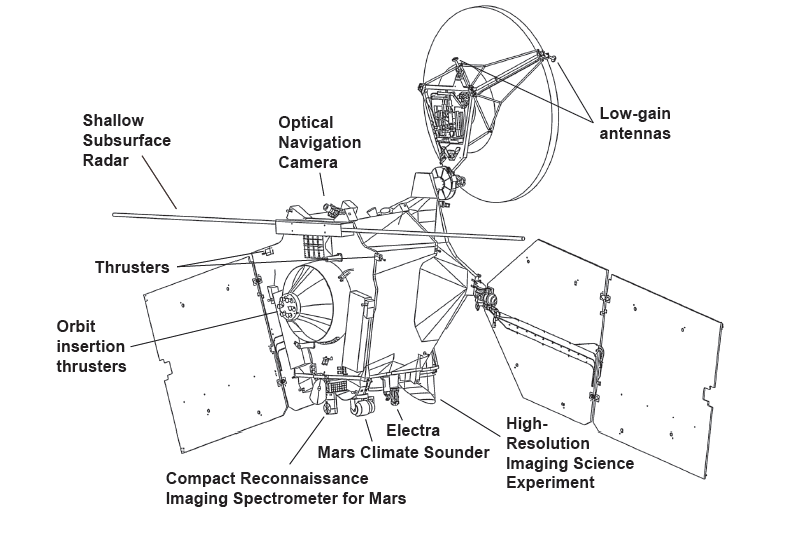
RF for links – for now
Thus far, all the links between Earth and spacecraft as well as between spacecraft use RF (“wireless”) technology. This technology is thoroughly tested, understood, and refined but has inherent bandwidth limitations and thus data-rate maximums. The bandwidth cannot just be increased “at-will” since doing so brings technical problems, noise issues, and spectrum conflict.
The primary tradeoffs at the spacecraft available are transit power, size, antenna design and size, and weight, as well as receiver performance. For the Earth-based transmitter and receiver, the tradeoffs are different (weight and power are less constrained, obviously) but the ability to find, lock, and track the space vehicle is a severe challenge, as well as providing a superior RF front end to deal with the extremely low received signal strength and poor signal/noise ratio (SNR).
When engineers think of optical data links, they usually associate the idea with a short-distance link (about a millimeter) via an optical coupler, or an optical-fiber link running hundreds and thousands of kilometers. Some also think of free-space optical links which support about ten-kilometer distance. But optical rather than RF links are also an alternative which is being actively explored by NASA and the European Space Agency (ESA).
In principle, this should offer an increase in data rate by at least ten and even as high as 100x due to the enormous bandwidth potential which the optical spectrum provides. Such optical links could be used to spacecraft in low or stationary orbit around the Earth, the moon, and even on deep-space missions (Figure 2). They could also be used for communication between spacecraft, especially those in orbit, as these satellites are increasingly expected to “coordinate” their activities.

But actually, using optical links is not as easy as just pointing a modulated laser beam from the space vehicle to the Earth station or vice versa. The spread of conventional RF energy, even when focused by a parabolic antenna, dilutes the effective power at the receiver. However, this gives the transmitter some flexibility and tolerance in aiming. The much-narrower energy spreading of the laser as an optical source is considered one of its virtues. Still, it has a downside as well: you’re either precisely on target (good), or you pretty much miss entirely (bad) (Figure 3). If you are on target, you can focus the energy at the receiver and achieve very good performance; if you are off-axis, the data rate drops to zero.
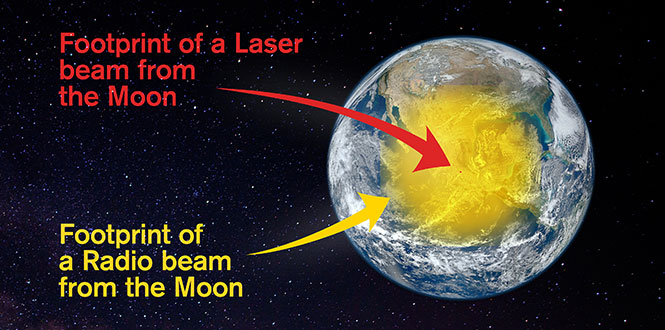
There are many problems beyond creating and modulating the focused laser beam. Among them are these:
- Finding the target and maintaining a pointing accuracy of microradians. This is hard enough to do with stationary objects, but space vehicles and the Earth are not stationary.
- Not only are they moving, but both source and receiver are not moving in simple straight lines; they are on complex curved paths, and the curvature details depend on the mission specifics.
- Optical signals travel the speed of light, of course, as do RF signals. But with the tightly focused optical signal and the huge distances of some space missions, the optical beam must be aimed where the target receiver will be when the light arrives. For RF, the beamwidth at the receiver is broad enough that this is not a problem (although it can be for very deep-space missions). Propagation delay to the moon is about 2 ½ seconds, while it takes between 5 and 20 minutes for a signal to travel the distance between Mars and Earth, depending on planet positions, and Pluto is 4.5 hours away.
- Finally, if the Sun is near the line-of-sight optical path, it will likely blind or severely limit the receiver. (She Sun also interferes with RF signals but to a lesser extent).
Despite these challenges, the potential benefits of using optical links to achieve higher data rates rather than relying solely on RF links are enticing. In the past decades, there have major efforts to develop and test practical systems. The next part of this article will look at some of these.
Related EE World Content
Free-space optical links, Part 1: Principles
Free-space optical links, Part 2: Technical issues
Free-space optical links, Part 3: Standard units
Phased-array antennas optimized for satellites, space vehicles
Challenges in designing electronics for satellites=
Infographic: How Are Satellites Shaping Our World?
External References
General
- NASA, “NASA Laser Communications Innovations: A Timeline”
- NASA, “Laser Communications: Empowering More Data Than Ever Before”
- NASA, “NASA Taking First Steps Toward High-speed Space ‘Internet’ “
- NASA, ”Lasers Light the Way”
- NASA, “Mars Reconnaissance Orbiter Press Kit”
- Chalmers University of Technology, “One photon-per-bit receiver using near-noiseless phase-sensitive amplification”
- Chalmers University of Technology, “Supplementary information for One photon-per-bit receiver using near-noiseless phase-sensitive amplification”
- NASA, “Pysche”
- NASA, “Pysche Mission Website”
DOSC
- Proceedings of the IEEE, “Deep-Space Optical Communications: Future Perspectives and Applications”
- NASA, “Lighten Up” – Deep Space Communications via Faraway Photons”
- American Institute of Aeronautics and Astronautics, “Toward a NASA Deep Space Optical Communications System”
- NASA, “Status of NASA’s Deep Space Optical Communications Technology Demonstration”
- Wikipedia, “Deep Space Optical Communications”
- SPIE, “Discovery deep space optical communications (DSOC) transceiver”
- NASA, “Deep Space Optical Communications (DSOC)”
LCRD
- NASA, “NASA’s Next Laser Communications Demo Installed, Integrated on Spacecraft”
- NASA, “Laser Communication Relay Demonstration (LCRD)”
- NASA, “Integrated LCRD Low-Earth Orbit User Modem and Amplifier Terminal (ILLUMA-T)”
SETH
- American Institute of Aeronautics and Astronautics, “SETH Technology Demonstration of Small Satellite Deep Space Optical Communications to aid Heliophysics Science and Space Weather Forecasting”
LLCD

